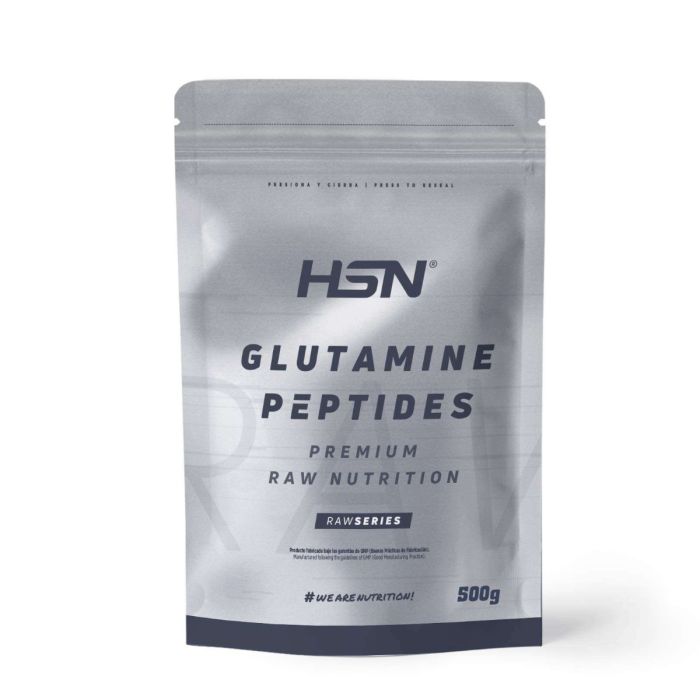- Glutamine peptides. Maximum assimilation.
- 100% vegetable origin.
- No Genetically Modified Organisms.
- Suitable for vegan diets.
WHAT IS GLUTAMINE PEPTIDES POWDER?
Glutamine peptides powder by RawSeries is a dietary supplement based on hydrolysed wheat protein, with 28% L-Glutamic acid.
L-glutamine (L-glutamic acid) is an amino acid that is especially present in meat, fish and dairy products and constitutes up to 60% of the amino acid composition of our muscle tissue (Cruzat et al., 2018). Even so, it is a non-(conditionally) essential amino acid
Glutamine peptides powder is a product suitable for vegetarians and vegans.
WHY TAKE GLUTAMINE PEPTIDES POWDER?
The presentation of glutamine peptides as an alternative to dietary supplements based on L-glutamine powder is based on the biological principle of kinetic advantage, which explains that the absorption of amino acids is favoured in the intestine with the presence of oligopeptides (Adibi y Morse, 1977).
A pure L-Glutamine powder dietary supplement is also available.
With the 9 essential amino acids
Despite the high presence of glutamine in the amino acid profile of the product, all the essential amino acids can be found in its peptides.
WHY BUY GLUTAMINE PEPTIDES AT HSN?
Don't miss out on all the features of glutamine peptides from HSN.
Price
Glutamine peptides are a rare dietary supplement.
This is because releasing the peptides requires a hydrolysis process that is not as widespread as whey treatment, and requires a high level of expertise and technical-industrial development.
HSN glutamine peptides are the best priced dietary supplement on the market thanks to our in-house production process.
100% Vegetable
The hydrolysed wheat protein used to obtain glutamine peptides is of 100% vegetable origin.
No ingredients of animal origin have been used in the production process of the food supplement.
Glutamine Peptides is a dietary supplement suitable for vegetarian and vegan diets.
Acidity
Glutamine peptides, due to the hydrolysis treatment of the raw material, are characterised by an intensely acidic taste.
Our product has been developed by enzymatic processing of the native proteins to an adjusted degree of hydrolysis, which significantly reduces the natural acidity and bitterness of the peptides.
HSN's glutamine peptides don’t have an intense flavour and can easily be camouflaged by mixing them with other products, such as Evolate 2.0 or EvoBCAA's 2.0.
Attention!
Glutamine peptides are hydrolysed wheat protein, characterised by the high presence of the amino acid L-glutamine in its composition.
It is important to understand that this product is not identical to the RAW amino acid 'L-glutamine'.
You can find pure L-glutamine in our catalogue as:
- L-Glutamine powder.
- Micronised Glutamine powder (Kyowa Quality®).
These products are characterised by the fact that they are instantaneous, and are suspended in the liquid medium without the need to stir the mixture with a spoon or something similar.
Using this procedure to try and homogenise glutamine peptides will inevitably lead to the appearance of lumps, due to the physicochemical characteristics of the product.
Glutamine peptides should be mixed into a shaker, to avoid the appearance of lumps in the mixture.
When shaking the shaker, a significant amount of foam will form due to the hydrolysis of the wheat protein (glutamine peptides). This is a normal process that does not affect the properties of the product, and which disappears by leaving the mixture to stand for a few minutes.
HOW DO GLUTAMINE PEPTIDES TASTE?
Glutamine peptides have an intensely bitter-sour and salty taste.

BIBLIOGRAPHIC REFERENCES
- Adibi, S. A., & Morse, E. L. (1977). The number of glycine residues which limits intact absorption of glycine oligopeptides in human jejunum. The Journal of Clinical Investigation, 60(5), 1008–1016.
- Cruzat, V., Rogero, M. M., Keane, K. N., Curi, R., & Newsholme, P. (2018). Glutamine: Metabolism and immune function, supplementation and clinical translation. Nutrients, 10(11).
ALGUNOS ESTUDIOS PARA AMPLIAR INFORMACIÓN
- Boron, W., Boulpaep, E. (Eds.) (2017) Medical physiology: a cellular and molecular approach Philadelphia, PA: Saunders/Elsevier.
- Castell, L. M., & Newsholme, E. A. (2001). The relation between glutamine and the immunodepression observed in exercise. Amino Acids, 20(1), 49–61.
- Castell, L. M., Poortmans, J. R., & Newsholme, E. A. (1996). Does glutamine have a role in reducing infections in athletes? European Journal of Applied Physiology and Occupational Physiology, 73(5), 488–490.
- Chamorro Vina, C., Fernandez del Valle, M., & Tacon, A. (2014). Excessive Exercise and Immunity: The J Shaped Curve.
- Coqueiro, A. Y., Rogero, M. M., & Tirapegui, J. (2019). Glutamine as an Anti-Fatigue Amino Acid in Sports Nutrition. Nutrients, 11(4).
- Shu, X.-L., Yu, T.-T., Kang, K., & Zhao, J. (2016). Effects of glutamine on markers of intestinal inflammatory response and mucosal permeability in abdominal surgery patients: A meta-analysis. Experimental and Therapeutic Medicine, 12(6), 3499–3506.
| Brand | Raw Series |
|---|
NUTRITIONAL FACTSGLUTAMINE PEPTIDES POWDER 1KG |
| daily doseper serving |
| SERVING SIZE: 1 SCOOP OF 5ML (4G) | ||
| DAILY DOSE: 2 SCOOPS OF 5ML (8G) | ||
| SERVINGS PER CONTAINER: 250 | ||
| Daily amount | |
|---|---|
| Glutamine Peptides | 8000mg |
AMINO ACIDS PROFILEGLUTAMINE PEPTIDES POWDER 1KG |
| Amino Acids Profile | x100g |
| Alanine | 2075mg |
| Arginine | 2905mg |
| Aspartic Acid | 2656mg |
| Cystine | 1743mg |
| Glutamic Acid | 30378mg |
| Glycine | 2656mg |
| Histidine | 1660mg |
| Isoleucine | 2988mg |
| Leucine | 5644mg |
| Lysine | 1411mg |
| Methionine | 1328mg |
| Phenylalanine | 4316mg |
| Proline | 9877mg |
| Serine | 4150mg |
| Threonine | 2158mg |
| Tryptophan | 747mg |
| Tyrosine | 2739mg |
| Valine | 3237mg |


Please complete your information below to login.
Sign In
Create New Account